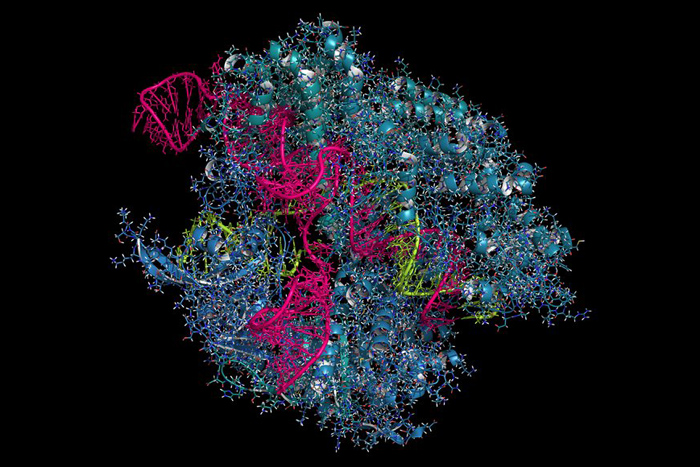
A weapon that viruses use in their neverending war with bacteria could be used to turn off the world’s most powerful gene-editing tool.
That, in turn, could reduce the risk that the bacterial cut-and-paste system, called CRISPR-Cas9, snips the wrong genes and introduces runaway genetic changes into humans or other species in the wild.
In a new study, scientists discovered that a tiny protein shuts off the system, and at least in a petri dish, the protein works in human cells, the researchers said.
"It's just basically a single protein that we can make in the cell or deliver to the cell that will turn off Cas9, [and] stop it from binding and cutting DNA," said study author Joseph Bondy-Denomy, a microbiologist at the University of California, San Francisco. [Video: How Does CRISPR-Cas 9 Gene Editing Work?]
Genetic find and replace
The CRISPR-Cas9 complex is a powerful tool in the bacterial immune defense against invading viruses. When a virus infiltrates a bacterial cell, the bacteria mobilize a sequence of DNA, called CRISPR, or "clustered regularly interspaced short palindromic repeats." The DNA consists of short blocks of repeating base pairs separated by spacer DNA. The bacteria copy and insert the viral DNA sequence into the CRISPR region and produce two strands of RNA. This RNA then associates with an enzyme called Cas9, which acts as a pair of guided scissors, homing in to the target viral DNA and snipping it out. Finally, the cell repairs the DNA, replacing the deleted DNA snippet with another replacement piece (supplied by scientists). Essentially, the CRISPR/Cas9 system can be used as a genetic "find and replace."
The CRISPR system's ease of use means it could be used for almost any gene-editing technique. For instance, doctors could one day edit human immune cells in the lab to recognize cancer cells, and then inject those cells back into a person as a targeted cancer treatment, Bondy-Denomy said. Recently, researchers in China used CRISPR to edit human embryos with serious genetic defects, though they did not allow the embryos to mature.
Off-target effects
However, the gene-editing system has a problem: It still sometimes cuts the wrong DNA sequences. Cas9 also sticks around too long; it takes about 24 hours for half of the Cas9 to be degraded by a cell, giving it plenty of time to make off-target cuts to DNA, Bondy-Denomy told Live Science.
Sign up for the Live Science daily newsletter now
Get the world’s most fascinating discoveries delivered straight to your inbox.
Therefore, if Cas9 has an "off" switch, it would make the possibility of human genetic engineering safer, Bondy-Denomy said.
He and his colleagues reasoned that viruses must have some way of switching off CRISPR/Cas9. To replicate, viruses often insert their own DNA into the bacteria's genome, coopting the cell’s genetic machinery to make many copies of viral DNA. By that logic, then, viruses must have a way to deactivate CRISPR/Cas9, or else sometimes the bacteria's immune system would identify the target viral DNA in its own genome, cut it and cause itself to self-destruct, Bondy-Denomy and his colleagues said.
"Cas9 should make an RNA that will then cleave the virus that happens to be in its own genome — it's not smart enough to know it's in its own genome,” Bondy-Denomy told Live Science. The team reasoned that if the bacterial cell is stable and it's not self-destructing, "then perhaps this virus is making an inhibitor protein."
Then, the team looked at 300 strains of Listeria bacteria, which cause food-borne illness, for signs that viral DNA had infiltrated the bacterial genome. Yet the bacteria were not self-destructing. From there, they looked for proteins that inactivated Listeria's version of Cas9, which is very similar to the one used in most labs around the world, called SpyCas9.
The team found four anti-CRISPR proteins, two of which worked against the commonly used SpyCas9, the researchers reported today (Dec. 29) in the journal Cell. In a petri dish, these two anti-CRISPR proteins also worked in human cells to deactivate the CRISPR/Cas9 system.
Safer engineering
The team still has to prove that using the anti-Cas9 proteins reduces the off-target cutting potential of Cas9, and they don't know how long the protein lingers in cells. However, if they can show the protein works in vivo, the new discovery would have the potential to make gene editing safer by eliminating Cas9 quickly.
"You don't rely on its passive degradation; you actually ensure it gets turned off," Bondy-Denomy said.
The technique could also be used for other applications. For instance, people have discussed using Cas9 to introduce a mutant gene into an entire population of mosquitoes to eradicate them or prevent the spread of certain diseases.
"This is essentially unleashing bioterror on an organism," which could have good, bad or completely unpredictable consequences, Bondy-Denomy said. So these anti-CRISPR proteins could be a handy off switch or control mechanism to use in case such species-wide engineering needs to be reined in, Bondy-Denomy said.
Original article on Live Science.

Tia is the managing editor and was previously a senior writer for Live Science. Her work has appeared in Scientific American, Wired.com and other outlets. She holds a master's degree in bioengineering from the University of Washington, a graduate certificate in science writing from UC Santa Cruz and a bachelor's degree in mechanical engineering from the University of Texas at Austin. Tia was part of a team at the Milwaukee Journal Sentinel that published the Empty Cradles series on preterm births, which won multiple awards, including the 2012 Casey Medal for Meritorious Journalism.










